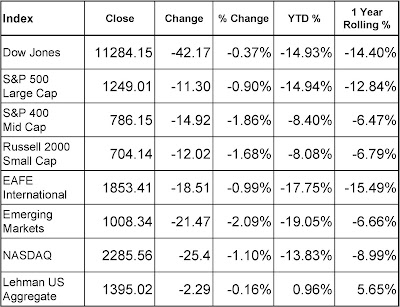Crude oil dropped $3.69 per barrel or -2.95 percent to close at 121.41 in New York trading. Since the peak of 145 early last month, crude prices have dropped slightly more than 16 percent – a correction, but not yet a bear market (one that we can all enjoy). Still, oil is up more than 25 percent for the year and is only back to prices seen in May.
Market Activity for August 4, 2008
Both personal income and personal spending were higher than Wall Street expected. As noted yesterday, personal income was expected to be lower by -0.20 percent, but actually came in positive at 0.10 percent. Personal spending registered a greater than expected 0.60%, versus the anticipated 0.40 percent.
As mentioned yesterday, one of the key considerations was whether or not consumers were spending their stimulus checks and the data bore that out. I don’t know how I failed to mention it (Brent will have my head), but along with the personal income and spending data came the personal consumption expenditures (PCE) that are considered a key measure of inflation.
The PCE is an index that measures the average increase in price for all domestic personal consumption. If you thought that this would be identical to the Consumer Price Index (CPI), you would be fooled by those tricky economic data collectors.
The CPI uses one set of expenditure weights for several years, where as PCE uses expenditure data from only the current and the previous period. In short, it looks at price changes from one period to another rather than looking at the most recent period compared to some predetermined base period.
The PCE index rose by 0.80 percent in June and gained 4.10 percent from the same month one year ago. Like its ugly cousin CPI, PCE also has a less volatile ‘core’ rate that excludes food and energy. The core PCE rate rose 0.30 percent in June, or 2.3 percent for the year ending in June. The Fed would like the core PCE rate below two percent.
Brent will also be aghast that I forgot to provide any guidance on productivity – one of the favorite measures of our nation’s great fortune. Despite the economic weakness, productivity has grown at an average annual rate of 2.50 percent. For those of you who don’t remember productivity rates in the 1970’s, it was around 0.80 percent.
Set your alarm clock for 2:15 pm EST, when the Fed announces their inaction. As stated yesterday, very few people believe that there will be any change in Fed policy. The key will be the statement. It is widely expected that rates will be unchanged, but that there will also be several dissenters instead of just one. That alone is a signal that rates are headed higher later this year, but the generally fragile nature of the financial system right now is a paramount consideration.
Have a great day!
Dave Ott, General Partner

No comments:
Post a Comment